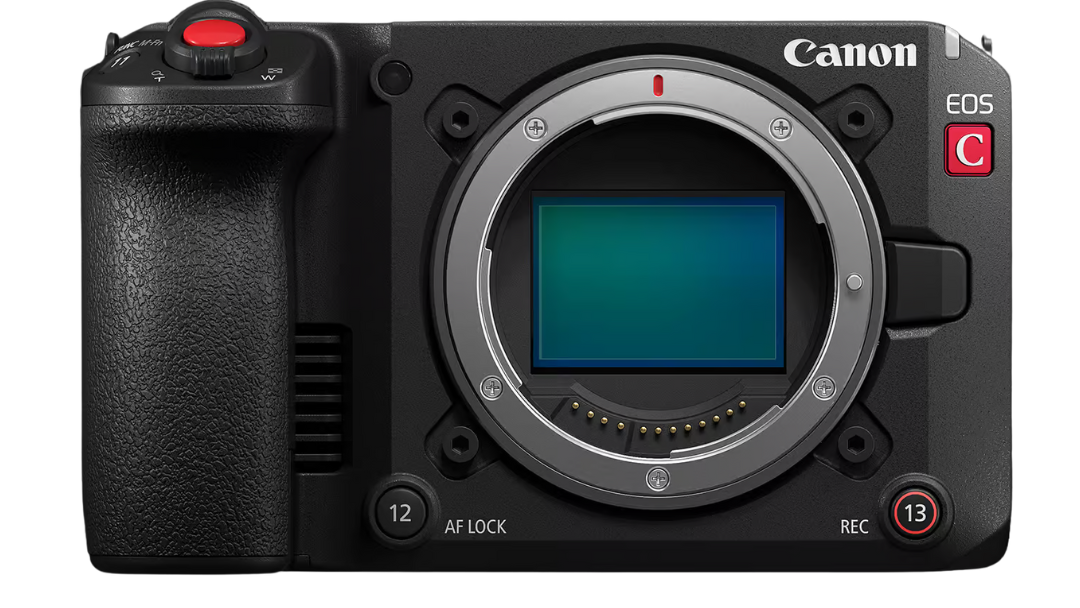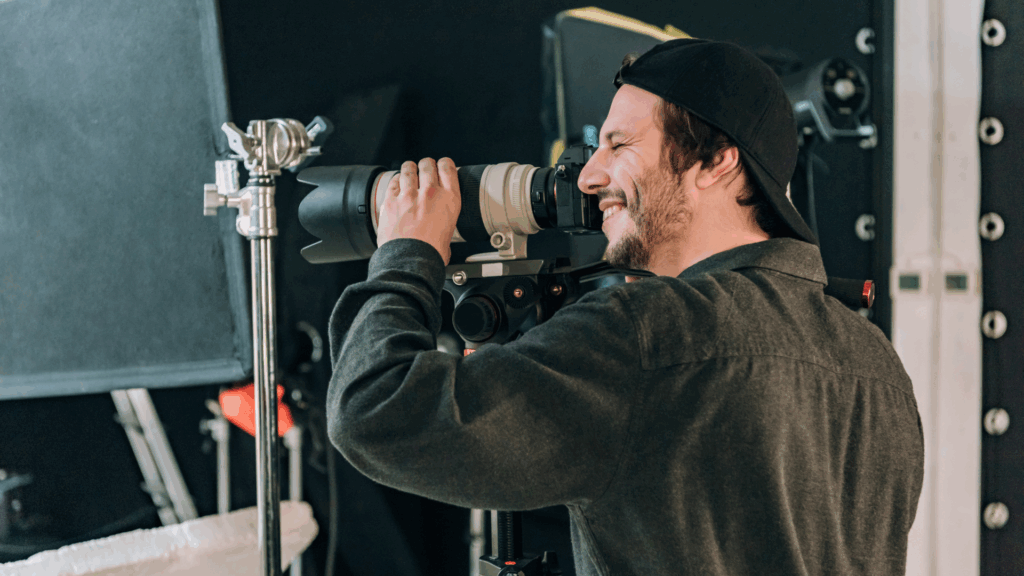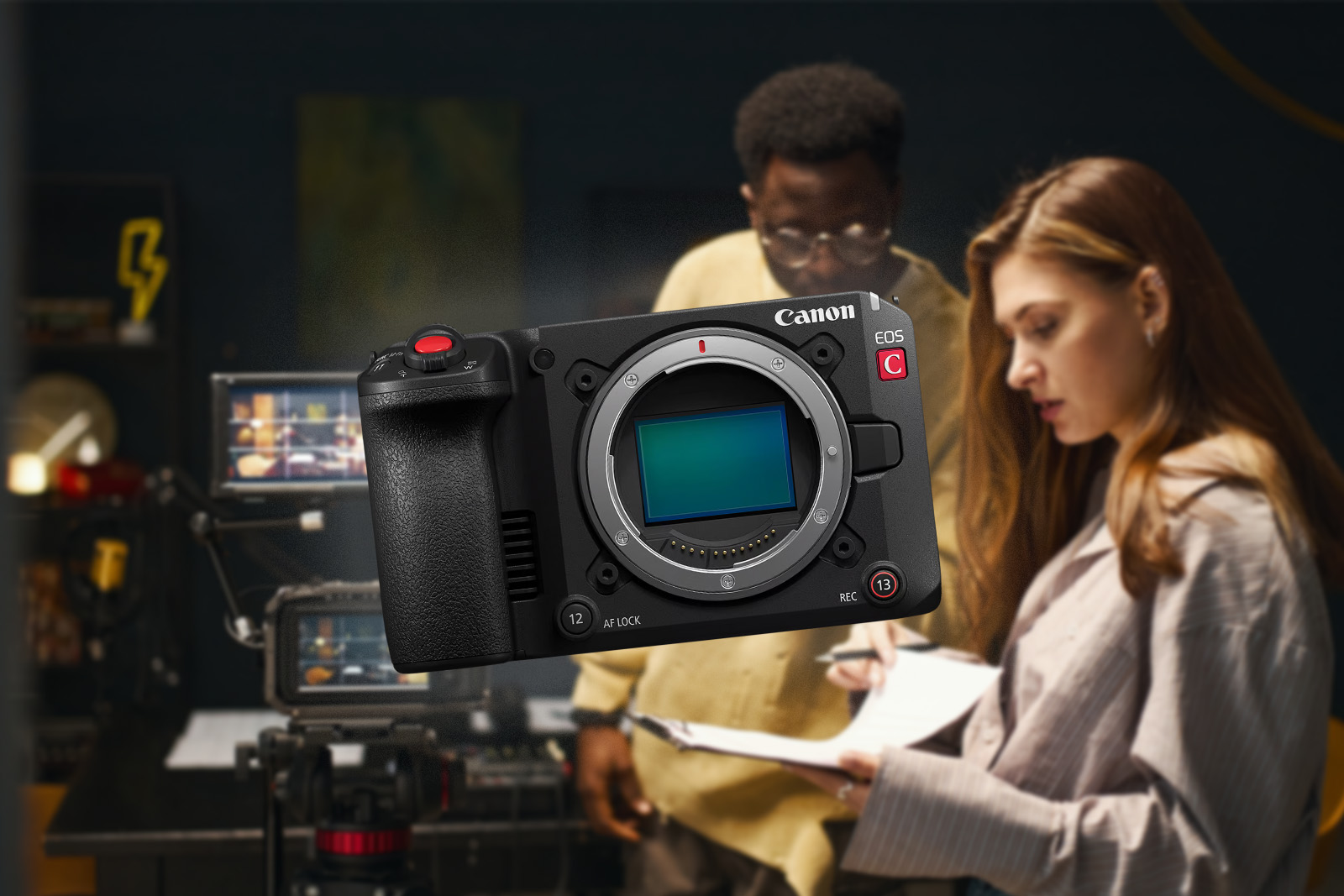Canon has pulled the curtain back on its newest cinema camera, the EOS C50, and it’s already sparking conversations across the filmmaking community. Sitting neatly between the beloved C70 and the workhorse C300 Mark III, the C50 arrives not as a replacement but as an expansion — a compact, forward-thinking tool that feels purpose-built for the way creators work in 2025.
At first glance, the C50 doesn’t scream revolution. It’s small, boxy, understated. But the magic is in what’s inside: a 7K Super 35mm sensor with Open Gate recording, Canon’s Dual Pixel autofocus, internal RAW capabilities, and the RF mount that’s fast becoming the backbone of Canon’s future. These aren’t just specs; they’re a clear statement. Canon is saying: “We hear you, and here’s a cinema camera ready for the realities of modern production.”

giving filmmakers cinema power without the bulk.
That reality looks different than it did even five years ago. Today’s filmmakers aren’t just thinking about theatrical distribution or broadcast delivery — they’re juggling feature projects, YouTube uploads, TikTok edits, and vertical Instagram reels, sometimes from the same shoot. The demand isn’t just for pristine image quality, but for flexibility, portability, and adaptability across platforms. This is where the C50 makes its case.
For indie filmmakers, wedding videographers, documentarians, and content creators who want the look of Canon’s cinema line without the heft of a larger rig, the C50 represents an intriguing new chapter. It’s not about replacing what came before — it’s about widening the spectrum of choices. And for a generation of shooters who want one camera to handle multiple demands, that’s a compelling promise.
Where the Canon EOS C50 Fits in Canon’s Cinema Line
When you look at Canon’s cinema lineup, the structure is fairly clear. The C300 Mark III and C500 Mark II sit at the top, built for major productions and broadcast environments. The C70, with its compact body and flexible codec support, has been the go-to for indie filmmakers who need a balance of quality and portability.
Now, the C50 slots in just beneath the C70, but not in a “budget” sense. Instead, it fills the gap for creators who want even more portability without sacrificing advanced features. Think of it as a sibling to the C70 rather than a competitor — the two cameras overlap in many ways but ultimately serve different shooting styles.
- C70: Ideal for broadcast, corporate, and documentary work.
- C50: Better suited for indie filmmakers, wedding shooters, and multi-platform content creators who prioritize portability and flexibility.
This strategy makes sense. Canon isn’t retiring or replacing cameras — they’re expanding the ecosystem. For users, it means more choices, and more importantly, the ability to find a camera that truly matches a workflow rather than forcing compromises.
7K Open Gate: Why It Matters
One of the C50’s standout features is its 7K Super 35mm sensor with Open Gate recording. On paper, it sounds like a spec-sheet brag. In practice, it’s a forward-looking tool that meets the evolving demands of content creation.
What is Open Gate?
Traditionally, cameras record using only part of the sensor — usually a 16:9 crop for standard video. Open Gate recording captures the entire sensor, giving filmmakers a taller frame to work with. This means more flexibility for reframing, cropping, or outputting multiple aspect ratios from a single take.
In 2025, this is invaluable. Filmmakers can shoot once in Open Gate and then deliver in:
- Horizontal 16:9 for YouTube or broadcast.
- Vertical 9:16 for Instagram Reels and TikTok.
- Cinematic 2.39:1 for film projects.
This multi-output workflow used to require separate cameras or awkward reframing. Now, with the C50, it’s built right into the workflow. For indie filmmakers and creators balancing multiple platforms, it’s a genuine game-changer.
Designed for Modern Filmmakers
Canon has made it clear: the C50 isn’t just a smaller cinema camera — it’s one designed with today’s filmmakers in mind. That means more than just image quality. It’s about how the camera fits into the realities of production in 2025.

lightweight body built for versatility.
- Portability: At under 2 pounds body-only, the C50 is light enough for gimbals, drones, or handheld rigs all day.
- Internal RAW: Shooters get access to Canon’s Cinema RAW Light formats, offering flexibility in post without massive storage headaches.
- Dual Pixel Autofocus: Trusted by Canon users for its reliability, making solo operation or small crews far more manageable.
- RF Mount: Ensures compatibility with Canon’s growing lineup of RF lenses, while also offering EF adaptability for those with existing glass.
This is the kind of package that speaks directly to indie creators, wedding filmmakers, and even documentary shooters who want to stay nimble while keeping cinema-quality output.
The RF Mount and Canon’s Future
If the C50 tells us anything, it’s that Canon is all-in on the RF mount. First introduced with their mirrorless EOS R cameras, the RF mount has slowly but surely expanded into the cinema world. The C50 doubles down on this direction.
The RF mount means:
- Access to Canon’s growing RF lens library, including high-speed primes and versatile zooms.
- Compatibility with EF lenses through adapters, which is huge for filmmakers with existing EF collections.
- Room for cinema-specific RF glass in the near future, something many believe Canon is preparing for.
The message is clear: RF isn’t just Canon’s mirrorless future — it’s the future of Canon Cinema EOS. And the C50 might be one of the most compelling reasons yet for filmmakers to start leaning into it.
C50 vs. C70: Complementary Tools
It’s natural to wonder how the C50 stacks up against the C70, given their proximity in Canon’s lineup. But it’s not about one replacing the other. Instead, they serve as complementary tools for different workflows.

and modern features may drive its used prices lower.
- The C70 is still the workhorse for documentary, broadcast, and long-form production where robust recording formats and extended I/O are critical.
- The C50 is the agile sibling, lighter, more compact, and better optimized for solo shooters and content creators who prioritize versatility.
Rather than cannibalizing each other, the two cameras expand options. Canon is essentially saying: “Choose the body that best fits your shooting style, and you’ll still benefit from our shared Cinema EOS DNA.”
Who Will Benefit Most from the C50
Not every camera is for every filmmaker — and that’s the point. The C50 will shine brightest in the hands of creators who need flexibility, portability, and cinema-grade performance in a compact package.
- Indie Filmmakers: Affordable access to 7K RAW and Open Gate recording for festival-ready projects.
- Wedding Filmmakers: Ability to capture both cinematic wides and vertical social edits from the same footage.
- Documentary Shooters: Lightweight enough for travel, strong enough to deliver broadcast-level images.
- Content Creators: A single camera that can serve YouTube, Instagram, TikTok, and short film projects without compromise.
For all these groups, the C50 offers something that’s been missing: a true multi-platform cinema camera that doesn’t feel like a compromise in any one direction.
The Bigger Picture: Canon’s Compact Cinema Vision
The EOS C50 isn’t just another entry in Canon’s lineup. It’s a signal of where the company is heading — toward a future where cinema-level tools are more accessible, portable, and adaptable than ever before.
Canon has always balanced tradition with innovation. With the C50, it’s clear they’re listening to the realities of modern creators. The inclusion of 7K Open Gate, internal RAW, RF mount, and Dual Pixel autofocus in a body this small shows that Canon isn’t holding back features for higher-end models. Instead, they’re broadening the ecosystem.
For filmmakers, that’s the real win. More choice. More flexibility. More tools that empower creativity rather than limit it.
Conclusion: A Camera for 2025 and Beyond
The Canon EOS C50 is more than a spec sheet. It’s a response to a changing filmmaking landscape where one camera often has to do it all. From indie sets to wedding aisles, from YouTube edits to cinematic premieres, the C50 offers a balance of portability and performance that feels right at home in 2025.
Is it Canon’s most powerful cinema camera? No. But it might be its most timely. By delivering features that resonate with the needs of modern creators, the C50 positions itself not just as a smaller sibling in the Cinema EOS line, but as a camera designed for an era when filmmaking is everywhere, on every platform, all at once.








